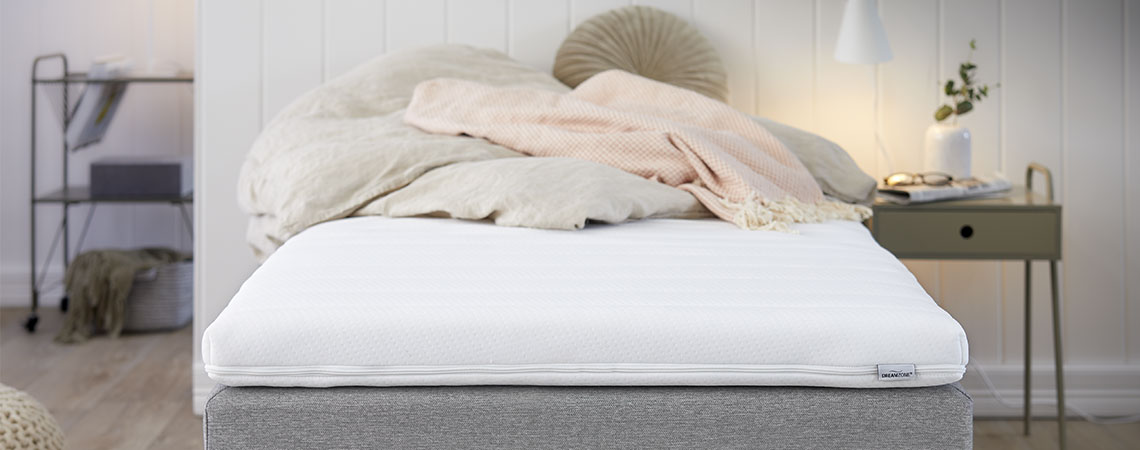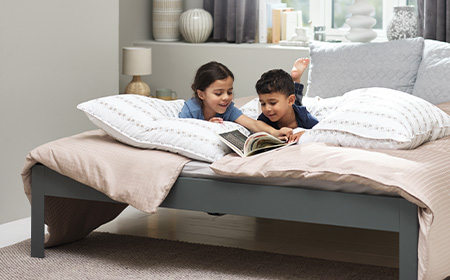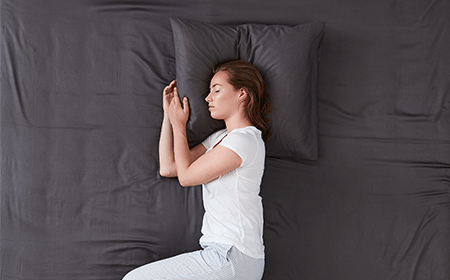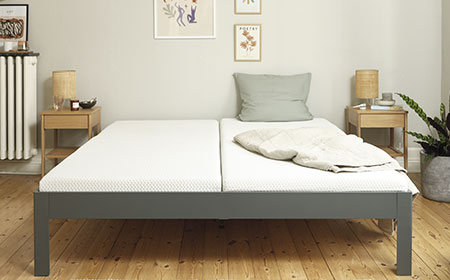A top mattress is a supplement to your mattress that can help you optimise and adjust the comfort of your bed. Perhaps you think your bed is a bit too soft or a tad too firm. A top mattress can help you adjust the firmness of your sleeping environment without having to buy a whole new bed.
A top mattress has different qualities depending on what type you choose. Latex, polyether foam, and memory foam are among the most common materials used in top mattresses, but you can also find models that consist of a mixture of different types of foam or so-called gel foam.
What is a top mattress?
A top mattress is a roughly 5 cm thick mattress that is placed on top of your regular mattress. With a top mattress, you can adjust the underlying mattress if you think it's too soft, too firm, or too warm. Additionally, a top mattress extends the lifespan of your bed.
"A good top mattress complements the comfort properties of the underlying mattress. The top mattress defines the feeling of the bed, and you can use it to make minor adjustments to your bed's overall comfort. But it will always be the underlying regular mattress that sets the basis for your bed's comfort and ergonomy."
– Peter, Category Manager, JYSK
Top mattresses are sometimes mistaken for mattress pads and vice versa. These two types of mattresses are not the same. A mattress pad primarily serves a hygienic purpose and only offers a small bit of comfort, while a top mattress can have a major impact on the comfort of your bed.
Read more about the difference between a top mattress and a mattress pad.
Should everyone use a top mattress?
Top mattresses are popular because they provide a relatively simple way to adjust the comfort of your underlying mattress. As our bodies change and develop over the years, a top mattress is a good way to make the adjustments we need to keep our beds comfortable and ergonomically supportive. That said, you can of course have a comfortable bed and mattress without adding a top mattress. It really depends on what type of bed and mattress you have.
Should you get a top mattress? Check out our comprehensive guide to choosing the right top mattress.
While a top mattress is ultimately an optional supplement, we recommend that you always use a mattress pad for hygienic reasons. A mattress pad protects your underlying mattress (and your top mattress if you choose to use one) against moisture. A mattress pad can also be washed in a washing machine, which makes it easy to keep your overall sleeping environment clean and healthy.
What does a top mattress do?
A top mattress adds an extra layer of comfort and support. If you have an older mattress that has lost some of its elasticity and comfort, a top mattress can give it new life. But a top mattress can do more than just that. A good top mattress can also change how the underlying mattress feels – even a brand-new one. If you think your underlying mattress is too firm, a top mattress can make it a bit softer so that it better matches your needs. Conversely, a top mattress can make a soft mattress feel firmer and more supportive.
If you are ever in doubt, our our staff in your local JYSK store can guide you in learning more about how mattresses and top mattresses work together and ultimately to find the comfort that is just right for you.
Materials in a top mattress
You can buy a top mattress made of several different types of material. The most popular materials are standard foam (also called PU, PUR foam or polyether foam), memory foam and latex but there are also top mattresses that are made of so-called hybrid foam and/or gel foam. The material affects the properties of the top mattress and therefore it's a good idea to be aware of the general advantages and disadvantages of the various types of top materials.
Polyether foam (standard foam)
- Also known as standard foam, regular foam, or PUR foam
- Affordable and moisture-absorbent top mattress
- Provides limited extra comfort
High-resilience foam (also known as cold foam)
- An oil-based foam that provides medium-firm to firm support
- Moisture-absorbent and ventilating
- Affordable and very durable
- Provides more comfort than polyether foam
Hybrid foam
- Made up of several different types of foam and is somewhere between polyether foam and memory foam when it comes to comfort
- In the same price class as memory foam
- Provides good comfort
Gel foam
- A soft and very adaptable foam which gives you a cloud-like comfort.
- In the same price class as memory foam
- Provides very good comfort
Memory foam (pressure-resistant foam)
- Along with latex and gel foam, the material on the market that provides the most comfort
- A material that forms to your body as you lie on it
- Giving a sinking and enveloping feeling
- Not as good at releasing excess heat, which means that a top mattress made of memory foam can feel rather warm
Latex (artificial latex and natural latex)
- Often a completely natural material made from rubber trees but can also be synthetic
- A top mattress is often made up of a combination of natural and synthetic latex
- Hypoallergenic material that minimises the presence of bacteria and fungi
- Good at releasing excess warmth, which makes it a good choice for those who feel too warm when they sleep
- A heavy material, which makes 100% natural latex cost quite a bit. The higher the percentage of natural latex, the more a top mattress will cost.
Comfort+ foam
- Flexible foam that adjusts to your body for better support
- Feels soft and has a high degree of mobility, so it is easy to get in and out of bed
- Absorbs your partner's movements in bed so you can sleep undisturbed
Learn more about choosing between a memory foam top mattress or a latex top mattress.
Core quality, core height and comfort zones – what do these terms mean?
When you're shopping for a top mattress, you may come across terms like core quality, core height and comfort zones. Below, we describe some common technical terms that are used to describe a top mattress.
What does core quality mean?
The term core quality refers to the density of the material in a top mattress. It is measured in kilos per cubic metre, or kg/m3. The higher the density, the better the top mattress will be at absorbing the pressure it is subjected to over time.
A memory foam top mattress with a core quality of 55 kg/m3 will in theory be more durable than a memory foam top mattress with a core quality of 35 kg/m3. But in terms of comfort, a high core quality isn't something you need to put a lot of thought into.
What does core height mean?
Core height refers to the thickness of the top mattress. The thicker a top mattress is, the more the material's qualities will be enhanced. With polyether foam, for example, a higher core height will mean a firmer top mattress. With latex, a higher core height will make the mattress feel softer.
Should you choose a firm or a soft top mattress? Get to know all there is to know.
What do comfort zones mean?
Comfort zones are often used to describe mattresses, but you don't hear about them quite as much when it comes to top mattresses. Nonetheless, some top mattresses do have comfort zones. When a mattress has comfort zones, it means that holes or patterns have been added to specific areas of the mattress in order to create special support zones. Some zones will be firmer or softer, depending on individual needs.
When you select a top mattress, it should complement the comfort zones of your underlying mattress unless you want to use the top mattress to neutralize the underlying mattress's comfort zones.
See our full assortment of top mattresses and find the right one for your needs.




